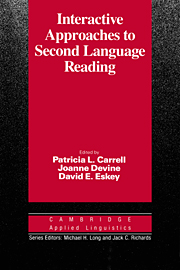Book contents
- Frontmatter
- Contents
- List of contributors
- Series editors' preface
- Preface
- Introduction: Interactive approaches to second language reading
- I INTERACTIVE MODELS OF READING
- II INTERACTIVE APPROACHES TO SECOND LANGUAGE READING – THEORY
- III INTERACTIVE APPROACHES TO SECOND LANGUAGE READING – EMPIRICAL STUDIES
- IV IMPLICATIONS AND APPLICATIONS OF INTERACTIVE APPROACHES TO SECOND LANGUAGE READING – PEDAGOGY
- Chapter 15 Interactive models for second language reading: perspectives on instruction
- Chapter 16 Interactive text processing: implications for ESL/second language reading classrooms
- Chapter 17 The relationship between general language competence and second language reading proficiency: implications for teaching
- Index
Chapter 16 - Interactive text processing: implications for ESL/second language reading classrooms
Published online by Cambridge University Press: 05 October 2012
- Frontmatter
- Contents
- List of contributors
- Series editors' preface
- Preface
- Introduction: Interactive approaches to second language reading
- I INTERACTIVE MODELS OF READING
- II INTERACTIVE APPROACHES TO SECOND LANGUAGE READING – THEORY
- III INTERACTIVE APPROACHES TO SECOND LANGUAGE READING – EMPIRICAL STUDIES
- IV IMPLICATIONS AND APPLICATIONS OF INTERACTIVE APPROACHES TO SECOND LANGUAGE READING – PEDAGOGY
- Chapter 15 Interactive models for second language reading: perspectives on instruction
- Chapter 16 Interactive text processing: implications for ESL/second language reading classrooms
- Chapter 17 The relationship between general language competence and second language reading proficiency: implications for teaching
- Index
Summary
The models and theory chapters in this volume, specifically Chapter 3 (Anderson and Pearson) and 5 (Carrell and Eisterhold), provide the theoretical underpinnings of this pedagogical chapter.
In recent research on second language reading (Carrell 1983; Carrell and Wallace 1983), it has been found that second language readers may not effectively utilize knowledge-based processes or top-down processing (i.e., specific contextual information they were supplied with) to facilitate comprehension. They may engage almost exclusively in text-based processing to the detriment of comprehension. By contrast, in other studies (Steffensen, Joag-dev, and Anderson 1979; Johnson 1981; Carrell 1981), some evidence has been found of overreliance on top-down processes. Thus, overreliance on either mode of processing to the neglect of the other mode has been found to cause reading difficulties for second language readers. Some second language readers are not efficient interactive text processors, either because they attempt to process in a totally bottom-up fashion, and may be effortful decoders at that, or because they attempt to process in a totally top-down fashion and are hence subject to schema failures or schema interference – see Carrell, Chapter 7 of this volume, for a discussion of the causes of text-boundedness and schema interference. For such inefficient second language readers, what can the second language reading teacher do?
This chapter proposes teaching a number of comprehension strategies designed to help nonnative readers to become interactive readers. In discussing these classroom suggestions, I shall classify them into two groups: (1) those designed to teach students to make effective use of the bottom-up processing mode, and (2) those designed to teach students to make effective use of the top-down processing mode.
- Type
- Chapter
- Information
- Interactive Approaches to Second Language Reading , pp. 239 - 259Publisher: Cambridge University PressPrint publication year: 1988
- 30
- Cited by

